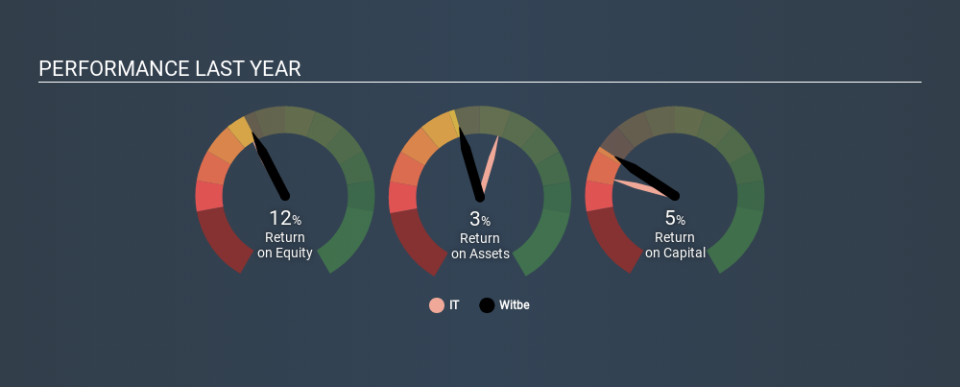How Do Witbe SA’s (EPA:ALWIT) Returns Compare To Its Industry?

Today we are going to look at Witbe SA (EPA:ALWIT) to see whether it might be an attractive investment prospect. To be precise, we'll consider its Return On Capital Employed (ROCE), as that will inform our view of the quality of the business.
Firstly, we'll go over how we calculate ROCE. Then we'll compare its ROCE to similar companies. Finally, we'll look at how its current liabilities affect its ROCE.
Return On Capital Employed (ROCE): What is it?
ROCE is a measure of a company's yearly pre-tax profit (its return), relative to the capital employed in the business. All else being equal, a better business will have a higher ROCE. In brief, it is a useful tool, but it is not without drawbacks. Renowned investment researcher Michael Mauboussin has suggested that a high ROCE can indicate that 'one dollar invested in the company generates value of more than one dollar'.
So, How Do We Calculate ROCE?
Analysts use this formula to calculate return on capital employed:
Return on Capital Employed = Earnings Before Interest and Tax (EBIT) ÷ (Total Assets - Current Liabilities)
Or for Witbe:
0.052 = €1.0m ÷ (€22m - €2.2m) (Based on the trailing twelve months to December 2019.)
Therefore, Witbe has an ROCE of 5.2%.
View our latest analysis for Witbe
Does Witbe Have A Good ROCE?
When making comparisons between similar businesses, investors may find ROCE useful. We can see Witbe's ROCE is meaningfully below the IT industry average of 12%. This could be seen as a negative, as it suggests some competitors may be employing their capital more efficiently. Separate from how Witbe stacks up against its industry, its ROCE in absolute terms is mediocre; relative to the returns on government bonds. Readers may find more attractive investment prospects elsewhere.
In our analysis, Witbe's ROCE appears to be 5.2%, compared to 3 years ago, when its ROCE was 3.0%. This makes us wonder if the company is improving. You can see in the image below how Witbe's ROCE compares to its industry. Click to see more on past growth.
When considering this metric, keep in mind that it is backwards looking, and not necessarily predictive. ROCE can be misleading for companies in cyclical industries, with returns looking impressive during the boom times, but very weak during the busts. ROCE is, after all, simply a snap shot of a single year. What happens in the future is pretty important for investors, so we have prepared a free report on analyst forecasts for Witbe.
Do Witbe's Current Liabilities Skew Its ROCE?
Short term (or current) liabilities, are things like supplier invoices, overdrafts, or tax bills that need to be paid within 12 months. Due to the way ROCE is calculated, a high level of current liabilities makes a company look as though it has less capital employed, and thus can (sometimes unfairly) boost the ROCE. To counteract this, we check if a company has high current liabilities, relative to its total assets.
Witbe has total assets of €22m and current liabilities of €2.2m. Therefore its current liabilities are equivalent to approximately 10% of its total assets. This very reasonable level of current liabilities would not boost the ROCE by much.
The Bottom Line On Witbe's ROCE
If Witbe continues to earn an uninspiring ROCE, there may be better places to invest. You might be able to find a better investment than Witbe. If you want a selection of possible winners, check out this free list of interesting companies that trade on a P/E below 20 (but have proven they can grow earnings).
If you like to buy stocks alongside management, then you might just love this free list of companies. (Hint: insiders have been buying them).
If you spot an error that warrants correction, please contact the editor at editorial-team@simplywallst.com. This article by Simply Wall St is general in nature. It does not constitute a recommendation to buy or sell any stock, and does not take account of your objectives, or your financial situation. Simply Wall St has no position in the stocks mentioned.
We aim to bring you long-term focused research analysis driven by fundamental data. Note that our analysis may not factor in the latest price-sensitive company announcements or qualitative material. Thank you for reading.


